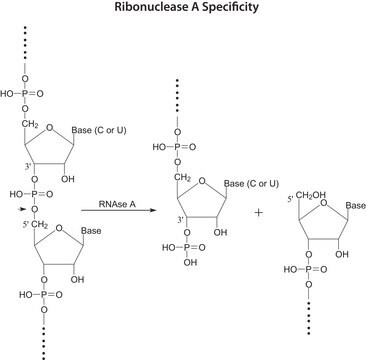Key Documents
D4527
Deoxyribonuclease I from bovine pancreas
Type II, lyophilized powder, Protein ≥80 %, ≥2,000 units/mg protein
Synonim(y):
DNase I, Deoxyribonucleate 5′-oligonucleotido-hydrolase
About This Item
Polecane produkty
pochodzenie biologiczne
bovine pancreas
Poziom jakości
typ
Type II
Postać
lyophilized powder
aktywność właściwa
≥2,000 units/mg protein
masa cząsteczkowa
~31 kDa
oczyszczone przez
chromatography
skład
Protein, ≥80%
metody
DNA extraction: suitable
rozpuszczalność
0.15 M NaCl: soluble 5.0 mg/mL, clear
przydatność
suitable for molecular biology
Zastosowanie
diagnostic assay manufacturing
diagnostic assay manufacturing
obecność zanieczyszczeń
Chymotrypsin ≤0.01%
Protease ≤0.005%
RNase ≤0.01%
Warunki transportu
wet ice
temp. przechowywania
−20°C
Szukasz podobnych produktów? Odwiedź Przewodnik dotyczący porównywania produktów
Zastosowanie
Działania biochem./fizjol.
Cechy i korzyści
Definicja jednostki
Postać fizyczna
Uwaga dotycząca przygotowania
Komentarz do analizy
inhibitor
Hasło ostrzegawcze
Danger
Zwroty wskazujące rodzaj zagrożenia
Zwroty wskazujące środki ostrożności
Klasyfikacja zagrożeń
Resp. Sens. 1
Kod klasy składowania
11 - Combustible Solids
Klasa zagrożenia wodnego (WGK)
WGK 3
Temperatura zapłonu (°F)
Not applicable
Temperatura zapłonu (°C)
Not applicable
Certyfikaty analizy (CoA)
Poszukaj Certyfikaty analizy (CoA), wpisując numer partii/serii produktów. Numery serii i partii można znaleźć na etykiecie produktu po słowach „seria” lub „partia”.
Masz już ten produkt?
Dokumenty związane z niedawno zakupionymi produktami zostały zamieszczone w Bibliotece dokumentów.
Klienci oglądali również te produkty
Produkty
To standardize a procedure for the enzymatic assay of Deoxyribonuclease I at Sigma-Aldrich St. Louis.
Protokoły
Standaryzacja procedury enzymatycznego oznaczania deoksyrybonukleazy I.
Nasz zespół naukowców ma doświadczenie we wszystkich obszarach badań, w tym w naukach przyrodniczych, materiałoznawstwie, syntezie chemicznej, chromatografii, analityce i wielu innych dziedzinach.
Skontaktuj się z zespołem ds. pomocy technicznej













